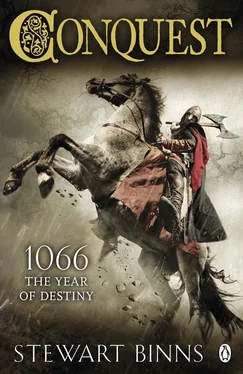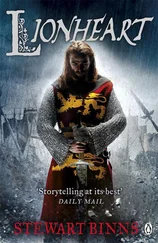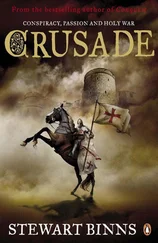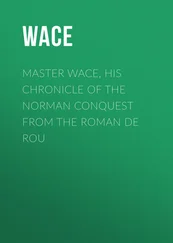‘Hereward, you have become a wise man as well as a great warrior. You are England’s last hope, and we are proud to follow you.’
Hereward did not respond. He put his hand on Einar’s shoulder, then hurried away down the slope, once again deep in thought, leaving his friends to follow in his wake.
The summer of arduous training at Clitheroe Hill continued for many weeks without interruption. No word came from the lookouts on Pen Hill, and the warning beacon was never lit.
The news everyone had been praying for finally arrived on a gloriously sunny day in the third week of August 1069.
A messenger from Edwin reported that the Danish fleet had left Jutland and sailed through the Skagerrak at the end of July. By early August, it had begun marauding along the south coast of England, just as Hereward had asked. Raiding parties had attacked Dover, Sandwich, Norwich and Ipswich; the Norman fleet was being systematically destroyed. As King Svein had promised, there were nearly 250 ships in a fleet commanded by his brother, Osbjorn, and two of his sons, Harold and Cnut. Christian, the Bishop of Aarhus, was present to make the cause a holy one, and the war party included opportunists and mercenaries from the Baltic and most of northern Europe.
It was a genuine invasion force. Hereward could not have hoped for more.
The new strategy swung into action immediately. Guarded by Hogor, the family remained at the camp on Clitheroe Hill as all twenty squadrons moved south to Chester to join forces with Eadric the Wild. By the time they arrived at the banks of the Dee, men were on the march everywhere and an upsurge of confidence was gaining momentum.
Harold’s sons had arrived from Ireland with 3,000 men in more than 60 ships. They had sailed up the river Tavy and made their headquarters at Tavistock. There had been a general rebellion throughout the whole of Cornwall and Devon, which was spreading to Dorset and Somerset. The latest reports said that Montacute castle, seat of the powerful Norman lord Robert of Mortain, was besieged. Hereward sent an urgent message of congratulations to Godwin Haroldson and asked him to hold the ground he already had, but to wait for a signal to advance on Winchester.
Edgar the Atheling, Earl Waltheof, Siward Bjorn and a large force had arrived from the North and were ready to attack York. The Danes had sailed up the Humber and lay in wait to the south of the city. Hereward ordered an immediate attack on the Norman garrison in the city.
His own rendezvous with Eadric the Wild had gone well; the two men found an immediate rapport and shared a common desire to rid England of the Normans. Eadric’s contingent of 300 included only 100 men from Bleddyn, Prince of Gwynedd – far fewer than Hereward had anticipated. Bleddyn’s brother, Rhiwallon, Prince of Powys, had been killed in a skirmish and his men had gone home to Wales in mourning. Nevertheless, despite the absence of Rhiwallon’s men, the combined force now under Hereward’s command was over 700, a sufficient number to ruffle the feathers of a few Normans.
Hereward planned to attack Shrewsbury before turning east to challenge Stafford and Nottingham. By then, he hoped William would be well to the north, busily engaging Edgar’s force and Osbjorn’s Danes, and effectively cut off from his stronghold in the South. That would be the time for Harold’s sons to march on Winchester, leading to a general rising in the South and leaving William outflanked and isolated.
As they made camp outside Shrewsbury, Hereward consulted his astrolabe. The date was 24 August 1069, one month short of the third anniversary of the eve of the Battle of Stamford Bridge, a coincidence he thought very auspicious.
The Norman fortification at Shrewsbury was formidable. The perimeter of the bailey was protected by a ditch, overlooked by a tall wooden palisade, and the motte was a mound of earth of considerable height, topped by a tall wooden tower. No such structures had been seen in England prior to William’s conquest and the English had no strategy for dealing with them. Hereward knew that, short of a prolonged siege for which he had neither the time nor the resources, a costly full-scale frontal assault was the only option. The Norman lord of Shrewsbury was Roger of Montgomery, an experienced soldier who had prepared well and whose initial defensive position was drawn up at the walls of his outer bailey.
Hereward’s and Eadric’s men suffered many casualties in more than half a dozen assaults before retreating to regroup. Norman casualties were only light, but they used a pause in the English attack to abandon their bailey and move into the even more secure tower on top of the motte. To mount an attack on this stronghold involved crossing the open ground of the bailey before clambering up the steep slope. Only then would they reach the fortification itself, an edifice nearly seventy feet high.
Nevertheless, the rebels launched three ferocious attacks, but failed to weaken the Norman position. As the English casualty toll mounted from the arrows, stones, hot oil and spears cascading from the battlements, they shot burning arrows to try to ignite the wooden structure and hurled bales of blazing straw in an attempt to set fire to its base, but the defenders were able to extinguish the flames before they caught hold. Then, as Hereward led a testudo of housecarls towards the base of the Norman motte, parts of the burgh of Shrewsbury caught light from incendiary arrows deliberately aimed at the houses by the Norman archers. Hereward called an immediate halt to the assault. The Normans cared nothing for the local population. If the fires were not put out quickly, Shrewsbury would be lost – and with it the support of the local people, many of whom were of Celtic descent. His men helped the populace douse the flames that threatened their homes before a general withdrawal was ordered.
Hereward decided to move on to Stafford, having prepared all kinds of subversive techniques, but the local Norman warlord had taken hostages into his bailey and threatened to burn them alive if the attacks continued. They made one more attempt at Tutbury, almost halfway to Nottingham, but, once again, their attacks could not breach the Norman defences without endangering the local population. They were left with no choice but to slip away to lick their wounds in the safe haven of the lower Pennines.
Once encamped, Eadric could offer little consolation for Hereward. ‘I’m afraid that we have no answer to these Norman towers.’
‘My good friend, there is always an answer. If we had ballista or siege engines, we could pound them into submission or we could starve them out. We don’t have the time or the resources to organize and protect the local people, and our numbers have fallen to a little more than five hundred. We need a new plan. Take the remainder of your men and go with Bleddyn and his Welshmen. I will give you four squadrons of mine. Retrace our route; keep the Normans locked in their towers, while I go north to see what is happening in York. Let’s hope that ours is the only part of the strategy that has not gone well. Our main hope now is the Danes.’
By the time Hereward’s force reached Tadcaster, they had received news that lifted their spirits once more. It was brought by Edwin, who, breathless with excitement, blurted out the details. When Edgar and the Danes attacked in overwhelming numbers, they had been able to scale the tower at York and achieve total success. The only Norman survivors were William Malet and Gilbert of Ghent and their families. It had been a fierce and bloody battle. Earl Waltheof had distinguished himself by killing dozens of Normans single-handedly, beheading them as they tried to escape through the gate of their tower.
However, there was one significant and disturbing piece of news, which Edwin saved for the end. ‘I’m afraid the city is in ruins, burned to the ground. The Normans torched everything before they scurried to their tower.’
Читать дальше












